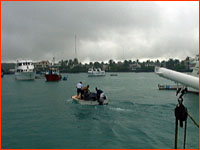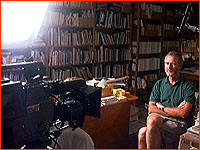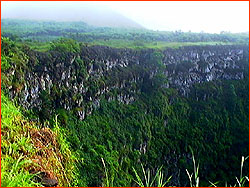 |
 |

|
Capitalizing on El Niño Rains March 3, 1998 By Mark Hoover previous | next Following is the last of the Galapagos dispatches to be disgorged from my defunct computer. Tomorrow I'll report in near real-time, from California, which has been pummelled over the last few weeks by heavy storms. It took over 40 hours for the Orca to reach the Galapagos again, after leaving the Ka'imimoana at approximately 95 degrees W, 2 degrees S. That's something like 320 miles at about eight diesel-powered miles per hour, a jogger's pace. 40 hours on the Orca. If you've been following these dispatches, I needn't elaborate.  As we approached the harbor at Puerto Ayoro, on the island of Santa Cruz, rain—El Niño rain—poured from the skies with near-Biblical vengeance,
as it had for the previous two days. Nonetheless, I stood on the foredeck,
drenched by warm rain, for the last half hour before we bid the Orca goodbye
for good. I could make out the buildings of the Darwin Research Institute on
the hillside above the harbor as we drew near. Despite the rain, the seas had
finally grown calmer.
As we approached the harbor at Puerto Ayoro, on the island of Santa Cruz, rain—El Niño rain—poured from the skies with near-Biblical vengeance,
as it had for the previous two days. Nonetheless, I stood on the foredeck,
drenched by warm rain, for the last half hour before we bid the Orca goodbye
for good. I could make out the buildings of the Darwin Research Institute on
the hillside above the harbor as we drew near. Despite the rain, the seas had
finally grown calmer.Water cascaded off every tin roof and gushed down every stone street in Puerto Ayoro, as we transferred our gear from the Orca to a launch for a short hop to shore, and then to a waiting minibus. Our superannuated driver could not recall a rainier wet season, and indeed the town looked lush, with flowers and leaves poking out from every parcel of open ground—not at all like the town I had seen in photographs, where cacti seemed to predominate. Barefoot children ran along the bus, shouting "Hello!" and "Bye Bye!" as we passed. Puerto Ayoro is the most populous of Galapagos' few settlements, perhaps 10,000 souls. Fernando said it was only a couple of months ago that electric power became available in the evening. To be here without power in the evenings wouldn't be such a bad thing once you got used to it, and if it helped keep the Galapagos off condo developers' lists, all the better. The Galapagos are an Ecuadorian national park, and the Ecuadorians seem serious about keeping the islands as close to pristine as possible...but inevitably, there is economic pressure from tourists.  The Darwin Institute's "campus," on a select spot overlooking the harbor,
consists of a half dozen or so low stone buildings, many of which were built by
a Swedish philanthropist in the 1970s. It serves as a field office for
visiting scholars, and a permanent base for a number of Galapagos scientists.
As far as I know, this was the first time it would also become a television
studio. The kind Institute librarian—a Chicagoan, it turned out—closed
the library early and turned it over to our film crew, so we could shoot an
interview with Mike McPhaden for the television show.
The Darwin Institute's "campus," on a select spot overlooking the harbor,
consists of a half dozen or so low stone buildings, many of which were built by
a Swedish philanthropist in the 1970s. It serves as a field office for
visiting scholars, and a permanent base for a number of Galapagos scientists.
As far as I know, this was the first time it would also become a television
studio. The kind Institute librarian—a Chicagoan, it turned out—closed
the library early and turned it over to our film crew, so we could shoot an
interview with Mike McPhaden for the television show. Our gear and bags were all soaked, and we dried things as best we could after checking into our low-slung hotel, before travelling up the hill to the Institute. Mike had saved a couple of polo shirts in a garbage bag, and proudly produced them for the interview, as though he were King Edward presenting the royal ermines to the court. The crew had kept the camera and sound gear dry with...garbage bags...and I had fashioned a makeshift poncho from a...garbage bag. When choosing an outfitter for an El Niño adventure, forget Abercrombie's—you need the Man from Glad. The interview came off without a hitch, and after not nearly enough sleep in a bed that didn't move, we arose early for our last investigation of the islands before boarding our plane in the afternoon and leaving Galapagos for good. Absent the pitching of the boat, I also got my first good satellite fix in a week, and called my slightly incredulous editor, who seemed to suspect I had buzzed out early and was calling from a pay phone in Miami. Actually, I was trying to figure out how to extend the trip an extra week. Once you're here, it's hard to leave. The airstrip—and our plane back to Ecuador—lay to the north of us, and we would take a road over the middle of the island to reach it. This meant an ascension into the highlands, perhaps 800 meters, where an entirely different microclimate prevailed. Along the way we planned to stop at a massive pit in the earth, hundreds of meters across and equally deep, flanked by the crests of the surrounding volcanoes. Here, our naturalist advised, we would find birds, especially the Santa Cruz variant of Darwin's finches, in superabundance.
As we drove higher up the massive caldera of the volcano that is the core of this island, mists appeared. Called garua, they are more than a fog but less than a rain, and for a third of each year (called the garua season, naturally), they moisten the highlands and encourage a lush microenvironment. Epiphytic ferns and mosses hang from the trees, creating shady retreats for the giant land tortoises that prefer to inhabit the highlands. During El Niño years, there is too much moisture, and the tortoises are driven to the lowlands. What's annoying to tortoises apparently doesn't affect the birds here. Nearing the highest point of the island, we pulled off the road, and hiked down a trail. Turning a bend, we came upon a vista that took my breath away. Before us lay a vast crater, a lost Eden with sheer basaltic walls. A profusion of birds populated its ramparts, its air, and the forest surrounding its rim. The garua-shrouded peaks of neighboring volcanic mountains enclosed the area, and
Finches landed on my feet, bathed in rain puddles lying in depressions in the hardened lava, and called out their territories from every surrounding tree. Spiders did a robust business, too, weaving stunning nets of exotic design in many sheltered corners. The mists played up and down the surrounding moors, and for a moment we all forgot we were in the Galapagos. I wish I could say that this was a moment of epiphany, but that would imply that human recognition was important here. It was not. An old script was being played out, one whose meaning had little to do with our human need to see change in terms of disaster, catastrophe, and aberration. To comprehend the immanent mystery of El Niño, it helps to stop thinking of it as a news event. El Niño gives with one hand as it takes with the other. In nature's double-entry accounting system, for every debit, there is a credit, for every check, a balance. A balance. Learned with my own senses, this is what I would take from the islands. And then it was time to leave for the plane. I spoke with Mike McPhaden as we boarded the rickety ferry to cross the channel to Baltra and our plane ride home. With characteristic simple modesty, he still seemed a little awed that NOVA was making a television show in which his life's work was featured. He said something again that he had said 10 days before. "I wish I knew more. I've seen so much here, learned so much. But I'm just an amateur." This from the man behind the world's most intense El Niño detection and measurement effort. Yes, Mike's an amateur, like another scientist who came here a hundred and fifty years ago during an El Niño year, and took with him visions and impressions that would incubate 20 years before flowering forth in a book that changed the world. His name was Charles Darwin. I hope that in your lifetime, if you find yourself on a scientific adventure—a journey to find answers to an old mystery, answers which will never be revealed in a newspaper or on cable news—that you have the privilege of such "amateur" company as Mike McPhaden. But even if you don't, take a lesson from Mike; your senses, your curiosity, and your passion are all you need, if you want to tackle the big questions. previous dispatch | next dispatch | table of contents Anatomy of El Niño | Chasing El Niño | El Niño's Reach Dispatches | Resources | Mail | Site Map | El Niño Home Editor's Picks | Previous Sites | Join Us/E-mail | TV/Web Schedule About NOVA | Teachers | Site Map | Shop | Jobs | Search | To print PBS Online | NOVA Online | WGBH © | Updated November 2000 |
||||||

